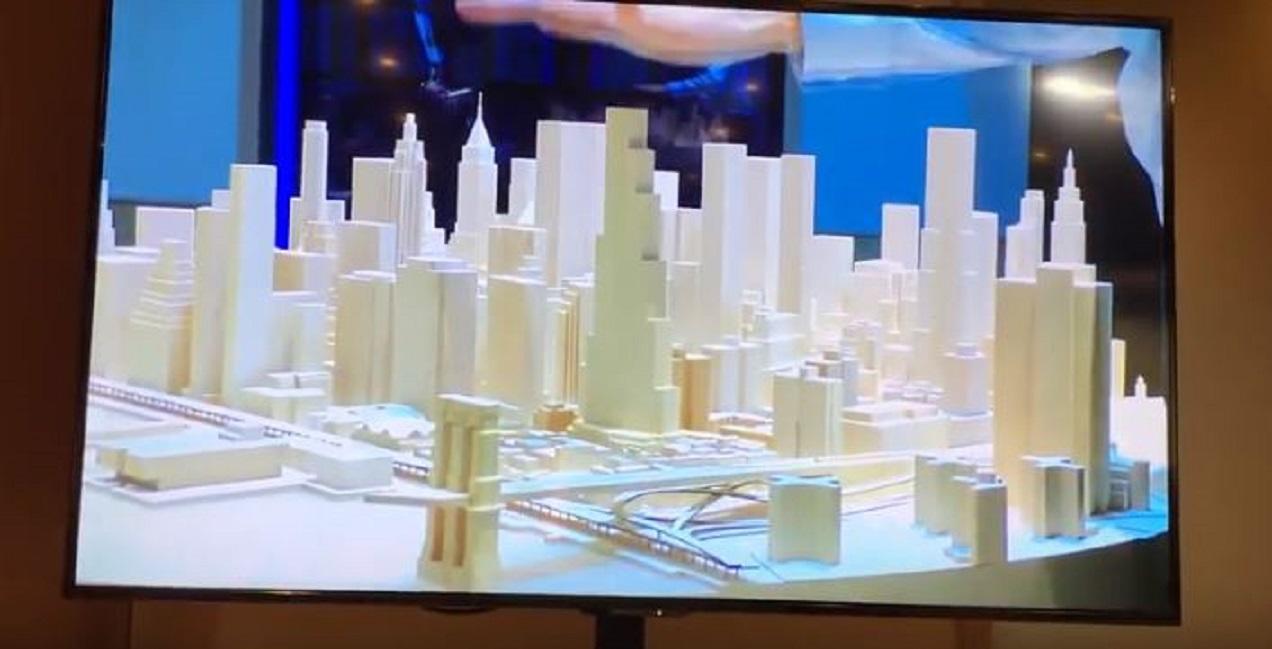Let the battles begin...
http://www.tribecatrib.com/content/a...rce-opposition
Another Tower Plan for the Seaport: 'There's Going to Be Fierce Opposition'
 Screen shot from video of Chris Cooper of Skidmore, Owings & Merrill as he shows a model of one of three development concepts for 250 Water Street to a Howard Hughes Corp. "stakeholder workshop." The one pictured is a model of a 990-foot-high building. Video courtesy of Seaport Coalition
Screen shot from video of Chris Cooper of Skidmore, Owings & Merrill as he shows a model of one of three development concepts for 250 Water Street to a Howard Hughes Corp. "stakeholder workshop." The one pictured is a model of a 990-foot-high building. Video courtesy of Seaport Coalition
By CARL GLASSMAN
Posted Mar. 10, 2020
Quote:
Six years after losing a bruising battle to build a tower at the South Street Seaport, the Howard Hughes Corp. has set the stage for its next development clash with the community.
Last week, at an invitation-only “stakeholder workshop,” Hughes executives and architects from Skidmore, Owings & Merrill revealed their options for a soaring project at 250 Water Street, buildings that would many times exceed zoning limits in the South Street Seaport Historic District. Among the ideas is a residential tower nearly 1,000 feet tall.
To sweeten the deal, the developer is dangling a host of tantalizing neighborhood investments and amenities, chief of which is a new building for the struggling South Street Seaport Museum.
|
Quote:
Along with a 990-foot-high tower are three other concepts for the site, now a parking lot stretching from Peck Slip and Beekman Street. They include an 880-foot tower that rises in stepped setbacks; two towers, one 770 feet tall, the other 385 feet; and a 285-foot-wide, 570-foot-high building.
Each project, which would include 200 below-market rate apartments, features a base about eight stories high meant to fit in with the low-rise neighborhood and, the developer hopes, convince the Landmarks Preservation Commission that the project is appropriate for the low-rise historic district.
|
Quote:
|
At the recent workshop, Skidmore, Owings & Merrill architect Chris Cooper pitched the towers as reasonably sized compared to other Lower Manhattan skyscrapers, while the base is in scale with the neighborhood. In a video, he is shown pointing to a model of the 990-foot-high building and saying: “You see, that base corresponds to the context. And then the height responds to the rest of the city.”
|
Quote:
“I don’t think they once mentioned that 250 Water Street is in the historic district,” said Paul Goldstein, the chair of Community Board 1’s Waterfront, Parks and Cultural Committee, who attended the workshop. “I don’t think the word historic district even arose.”
Community Board 1 and local activists are expected to fight any large-scale project at 250 Water Street during the public land use review required for a zoning variance. And they are likely to oppose the developer’s efforts to scrap a city rule that specifically prohibits its needed transfer to 250 Water Street of 450,000 square feet of air rights from two Seaport properties that Hughes Corp. leases from the city.
That air rights transfer would almost certainly need the consent of Councilwoman Margaret Chin, who said she has her own doubts. She told the Trib in a statement: “With the future of the Seaport District at stake, the community’s priority is clear: we need a conversation about bulk and density that fully takes into account the context of this historic area. At this point, I don't believe the case has been properly made to residents that an air rights transfer is even necessary.”
|
Quote:
On a possible air rights transfer, a spokesperson for the city’s Economic Development Corp., the agency that oversees the Seaport properties, emphasized in a statement the long road ahead for the developer, which has to go through a “competitive public procurement as well as multiple land use approval processes.”
“As stewards of the Historic South Street Seaport,” the spokesperson said, “we take the community’s priorities seriously and look forward to engaging further with local stakeholders on how to best equip the neighborhood for the future.”
Hoping to pave a path forward, Hughes Corp. is promising an array of local improvements, including a new $50 million, 30,000-square-foot building for the South Street Seaport Museum at John and South Streets, and a $100 million, 75,000 square-foot building for an undetermined community use, at the site of the current New Market Building. Then there are the host of other possible local improvements, from an upgraded play street for the Peck Slip School to a community theater to a skate park.
|
Quote:
“We have a rare opportunity to bring affordable housing to an area where it’s in short supply, secure the long-term future of the Seaport Museum, boost resiliency along the waterfront and provide public realm and infrastructure improvements across the historic neighborhood,” a Howard Hughes spokesman said in a statement.
“This neighborhood like any other neighborhood could use improvements. And we like a lot of the things that have been discussed,” Goldstein said. “But the price is not the price we’re willing to pay, and we’re not that desperate for these things to give away ten percent of the historic district.”
|
Quote:
In a resolution passed last November, CB1 repeated its long-standing position for keeping the existing zoning in the Seaport Historic District that “ensures that new buildings maintain the low scale character of this very special area.” The resolution supports a “Seaport Strategic Vision” drawn up by the Seaport Coalition, an activist group that calls the current height limits non-negotiable.
“We certainly can’t stomach the idea that you can buy your way out of the zoning and that you can buy your way out of history,” said Michael Kramer, a leader of the coalition, which includes Children First, Save Our Seaport, and residents of Southbridge Towers. “This is a very fragile and unique neighborhood.”
|
• Video Link

 Concept renderings, inside and out, of a new building for the South Street Seaport Museum at South and John Streets. Credit: Skidmore, Owings & Merrill and the Howard Hughes Corp.
Concept renderings, inside and out, of a new building for the South Street Seaport Museum at South and John Streets. Credit: Skidmore, Owings & Merrill and the Howard Hughes Corp.
I grabbed some additional shots...




__________________
NEW YORK is Back!
“Office buildings are our factories – whether for tech, creative or traditional industries we must continue to grow our modern factories to create new jobs,” said United States Senator Chuck Schumer.
|



